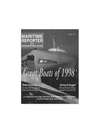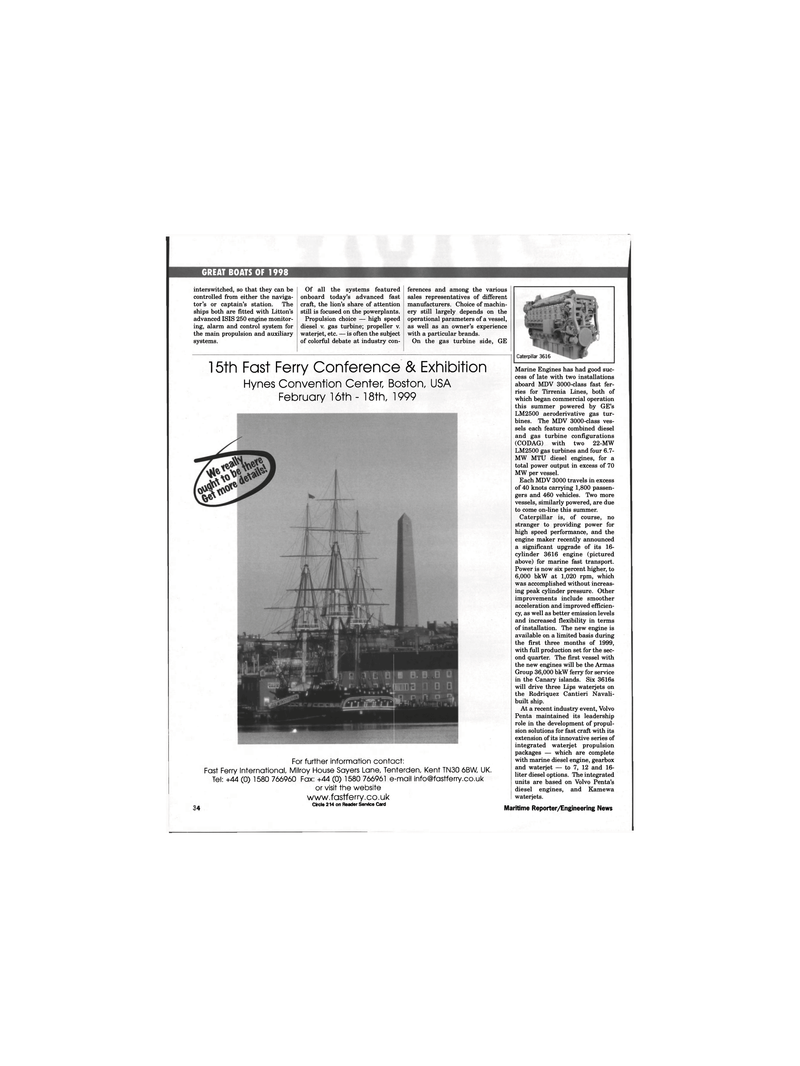
Page 34: of Maritime Reporter Magazine (January 1999)
Read this page in Pdf, Flash or Html5 edition of January 1999 Maritime Reporter Magazine
GREAT BOATS OF 1998
Caterpillar 3616 interswitched, so that they can be controlled from either the naviga- tor's or captain's station. The ships both are fitted with Litton's advanced ISIS 250 engine monitor- ing, alarm and control system for the main propulsion and auxiliary systems.
Of all the systems featured onboard today's advanced fast craft, the lion's share of attention still is focused on the powerplants.
Propulsion choice — high speed diesel v. gas turbine; propeller v. waterjet, etc. — is often the subject of colorful debate at industry con- ferences and among the various sales representatives of different manufacturers. Choice of machin- ery still largely depends on the operational parameters of a vessel, as well as an owner's experience with a particular brands.
On the gas turbine side, GE
Marine Engines has had good suc- cess of late with two installations aboard MDV 3000-class fast fer- ries for Tirrenia Lines, both of which began commercial operation this summer powered by GE's
LM2500 aeroderivative gas tur- bines. The MDV 3000-class ves- sels each feature combined diesel and gas turbine configurations (CODAG) with two 22-MW
LM2500 gas turbines and four 6.7-
MW MTU diesel engines, for a total power output in excess of 70
MW per vessel.
Each MDV 3000 travels in excess of 40 knots carrying 1,800 passen- gers and 460 vehicles. Two more vessels, similarly powered, are due to come on-line this summer.
Caterpillar is, of course, no stranger to providing power for high speed performance, and the engine maker recently announced a significant upgrade of its 16- cylinder 3616 engine (pictured above) for marine fast transport.
Power is now six percent higher, to 6,000 bkW at 1,020 rpm, which was accomplished without increas- ing peak cylinder pressure. Other improvements include smoother acceleration and improved efficien- cy, as well as better emission levels and increased flexibility in terms of installation. The new engine is available on a limited basis during the first three months of 1999, with full production set for the sec- ond quarter. The first vessel with the new engines will be the Armas
Group 36,000 bkW ferry for service in the Canary islands. Six 3616s will drive three Lips waterjets on the Rodriquez Cantieri Navali- built ship.
At a recent industry event, Volvo
Penta maintained its leadership role in the development of propul- sion solutions for fast craft with its extension of its innovative series of integrated waterjet propulsion packages — which are complete with marine diesel engine, gearbox and waterjet — to 7, 12 and 16- liter diesel options. The integrated units are based on Volvo Penta's diesel engines, and Kamewa waterjets.
Maritime Reporter/Engineering News 15th Fast Ferry Conference & Exhibition
Hynes Convention Center, Boston, USA
February 16th - 18th, 1999
For further information contact:
Fast Ferry International, Milroy House Sayers Lane, Tenterden, Kent TN30 6BW, UK.
Tel: +44 (0) 1580 766960 Fax: +44 (0) 1580 766961 e-mail [email protected] or visit the website www.fastferry.co.uk
Circle 214 on Reader Service Card 42

 33
33

 35
35
